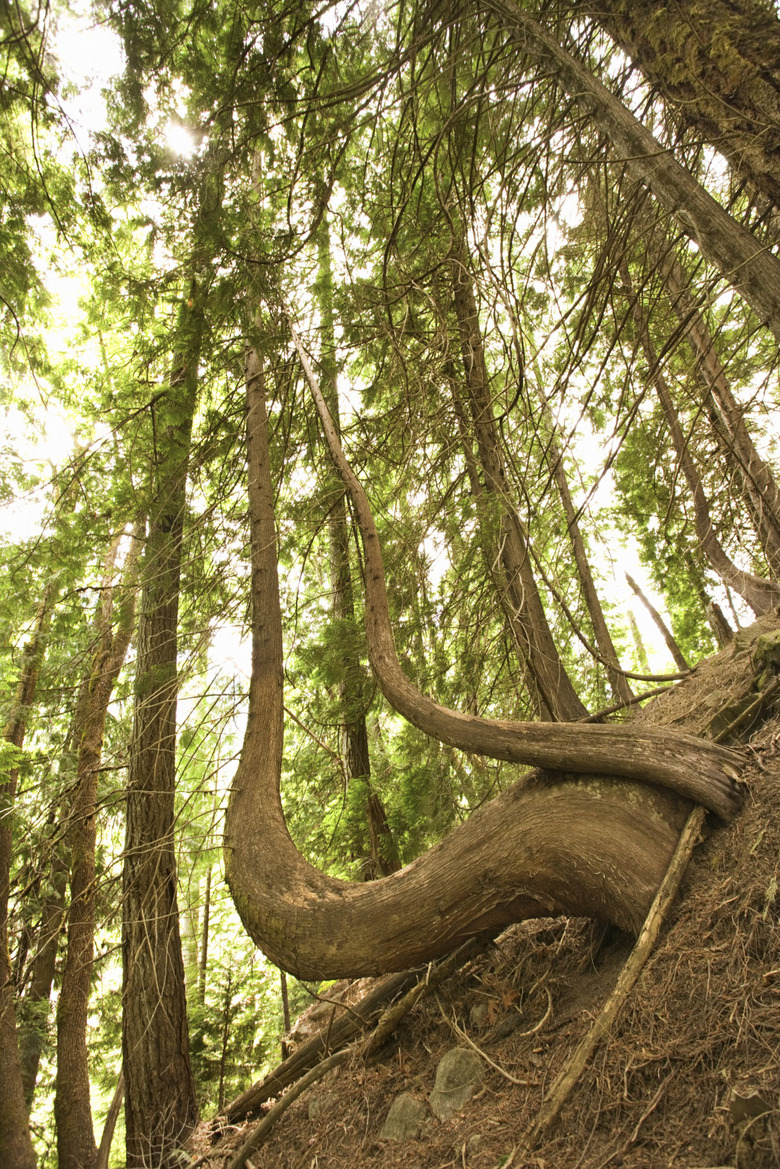How Can Trees Help Prevent Soil Erosion?
Trees reduce the effect of erosive forces using their root systems and foliage. Tree roots begin as thick stems that branch into fine filaments to create a network of flexible tendrils that help stabilize the soil around the tree and hold it in place. The leaves and branches of trees create a flexible screen that reduces the force of wind and rain in the surrounding area. You can increase the beneficial impact of trees on areas with eroding soils by planting them in groups.
Erosive Forces
Erosive Forces
Wind and rain are two of the main forces that erode bare soil. Droplets of rain water gain momentum as they fall which provides enough force to move particles of dirt when they reach the ground. Rain trapped on the surface of the soil can carry loose soil particles downhill under the influence of gravity. Runoff is exacerbated in areas of bare soil since the soil is exposed to full force of wind and rain. Bare areas exposed to strong winds can lose significant amounts of soil if the ground is dry and there are no roots present to hold the soil in place.
Root Systems
Root Systems
The root systems of most trees consist of several large roots that branch out into many smaller roots. The root systems of many trees extend out into the surrounding soil far beyond their branches. Tree roots hold the soil in place and improve the drainage of the soil. The roots prevent soil compaction and help water soak into the ground instead of flowing over its surface. Tree roots tend to grow more deeply than other plants and provide a greater resistance to erosion on hillsides than grasses and other small plants.
Foliage
Foliage
Tree foliage intercepts falling rain water and reduces the force it exerts when it hits the ground. Rain water caught in a tree's foliage is channeled over the stems and down the trunk until it soaks into the soil. This process helps rainwater penetrate the soil instead of washing over it and reduces the force that falling rain drops exert on the soil. Although the area a single tree protects is limited, trees with broad foliage planted together can reduce the force of falling rain drops over a significant area.
Windbreaks
Windbreaks
Windbreaks are rows of trees planted closely together on the windward side of an area vulnerable to the wind's erosive force. The overlapping foliage of trees planted in a windbreak helps limit the force of the wind, and reduces the amount of soil that is carried away during heavy winds. The most effective wind breaks use parallel rows of different species that grow thick foliage at different heights to ensure that the wind is controlled from the ground level up.
Choosing Trees
Choosing Trees
Newly planted trees need to grow for several years before they will be large enough to have an impact on erosion. The best trees for preventing erosion allow grasses or cover crops to grow under their foliage while the tree is establishing itself. Trees with broad root systems that seek water aggressively help hold the soil in place, increase the amount of water that can infiltrate the soil and help prevent the soil from becoming saturated for long periods of time. Some of the better choices for trees that prevent erosion are fir trees, big-leaf maples, pine trees and willows.
The best trees for windbreaks have a rapid growth rate and dense foliage that significantly reduces the force of the wind. Trees that withstand crowding work well in windbreaks, since closely planted trees provide a more effective wind barrier. Conifers – such as cedar, cypress and hemlock – make the best choices for windbreaks.
Cite This Article
MLA
Thompson, Daniel. "How Can Trees Help Prevent Soil Erosion?" sciencing.com, https://www.sciencing.com/how-can-trees-help-prevent-soil-erosion-12620837/. 30 September 2021.
APA
Thompson, Daniel. (2021, September 30). How Can Trees Help Prevent Soil Erosion?. sciencing.com. Retrieved from https://www.sciencing.com/how-can-trees-help-prevent-soil-erosion-12620837/
Chicago
Thompson, Daniel. How Can Trees Help Prevent Soil Erosion? last modified March 24, 2022. https://www.sciencing.com/how-can-trees-help-prevent-soil-erosion-12620837/
